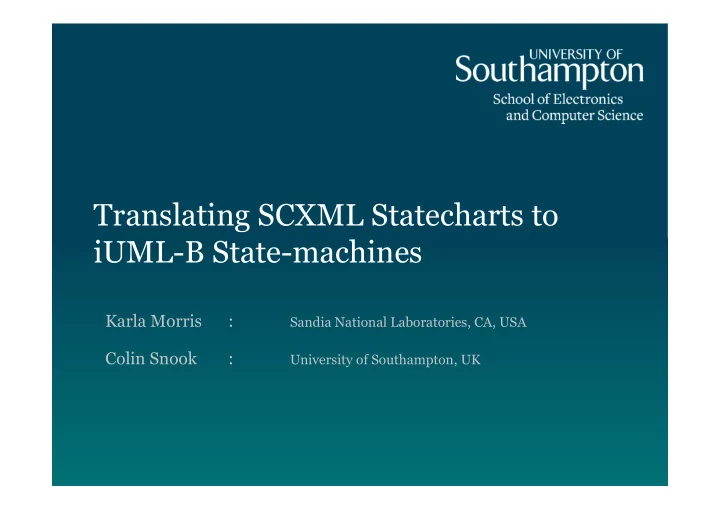

Translating SCXML Statecharts to iUML-B State-machines Karla Morris : Sandia National Laboratories, CA, USA Colin Snook : University of Southampton, UK
Motivation • Event-B provides verification by formal proof… • … but notation is restricted to simplify verification. • Engineers are used to a richer notation.. • .. they may find the restrictions difficult to accept. • iUML-B State-machines help but still close to Event-B. • Can Harel style state-chart semantics be reconciled with iUML- B? • We investigate a translation from SCXML state-charts to iUML- B state-machines (and hence to Event-B). Rodin Workshop 2016 – Linz, 23 rd May
SCXML • State Chart XML : – State Machine Notation for Control Abstraction • XML notation • Harel Statecharts • Executable (via simulator tools) • Related to CCXML Call Control XML, event-based telephony Rodin Workshop 2016 – Linz, 23 rd May
SCXML <state id="on"> <initial> <?xml version="1.0"?> <transition target="idle"/> <scxml xmlns="http://www.w3.org/2005/07/ </initial> scxml" <!-- on/pause state --> version="1.0" <transition event="turn.off" target="off"/> datamodel="ecmascript" <transition cond="timer >= cook_time" target="off"/> initial="off"> <state id="idle"> <!-- default immediate transition if door is shut --> <!-- trivial 5 second microwave oven example --> <transition cond="door_closed" target="cooking"/> <datamodel> <transition event="door.close" target="cooking"> <data id="cook_time" expr="5"/> <assign location="door_closed" expr="true"/> <data id="door_closed" expr="true"/> <!-- start cooking --> <data id="timer" expr="0"/> </transition> </datamodel> </state> <state id="cooking"> <state id="off"> <transition event="door.open" target="idle"> <!-- off state --> <assign location="door_closed" expr="false"/> <transition event="turn.on" target="on"/> </transition> </state> <!-- a 'time' event is seen once a second --> <transition event="time"> <assign location="timer" expr="timer + 1"/> </transition> </state> </state> </scxml> Rodin Workshop 2016 – Linz, 23 rd May
SCXML cont. red = external trigger event [black] = conditional, no trigger Rodin Workshop 2016 – Linz, 23 rd May
iUML-B Statemachines Rodin Workshop 2016 – Linz, 23 rd May
iUML-B Statemachines Rodin Workshop 2016 – Linz, 23 rd May
Similarities • Hierarchical nested state-charts • Transitions with – Conditions / Guards – Actions • States can have Entry and Exit Actions – (use with care in iUML-B) Rodin Workshop 2016 – Linz, 23 rd May
Differences • Event-B has.. – Refinement – Invariants • SCXML has.. – External Trigger events • Hence transitions do not have a name/label – Sequential actions – Run to Completion – Big step/little step Rodin Workshop 2016 – Linz, 23 rd May
SCXML Extensions • XML tools allow new meta-model ‘namespaces’ to be introduced. – Existing SCXML tools will ignore them • Needed in order to support: – Refinement levels (new attribute <iumlb:refinement …>) – Invariants (new element <iumlb:invariant …>) – Guards (new element <iumlb:guard …>) Rodin Workshop 2016 – Linz, 23 rd May
SCXML Extension Attributes Rodin Workshop 2016 – Linz, 23 rd May
Example extended SCXML (extensions are the bits in red) <datamodel iumlb:refinement="2"> <data expr="false" id="Gate_In.Block" iumlb:type="BOOL"/> </datamodel> <!-- Other model details --> <state id="BLOCKED"> <transition cond="[On_In.CardAccept==true]" target="UNBLOCKED"> <iumlb:guard name="gd1" predicate="On_In.CardAccept==true" refinement="2"/> <assign expr="true" location="Gate_In.Block" iumlb:refinement="3"/> </transition> <onentry> <assign expr="true" location="Gate_In.Block"/> <assign expr="false" location="On_In.Reset"/> </onentry> <onexit> <assign expr="false" location="Gate_In.Block"/> </onexit> <iumlb:invariant predicate="Gate_In.Block == TRUE" name="GateCondition"/> </state> Rodin Workshop 2016 – Linz, 23 rd May
Initial translation supports.. • Data models • Hierarchical nested statemachines • Parrallel Statemachines • ‘When’ Transitions (label) • Transition parameters, guards and actions • Invariants • Initial and Final states • Refinement (superposition only) Rodin Workshop 2016 – Linz, 23 rd May
Diagram of SCXML Rodin Workshop 2016 – Linz, 23 rd May
Example – generated iUML-B Rodin Workshop 2016 – Linz, 23 rd May
Next steps • Try modelling the run to completion semantics • E.g. trigger events create a token, – A new token can only be consumed when no transitions are enabled • Try enforcing transition run-to-completion sequences • Still omit sequencing of actions Rodin Workshop 2016 – Linz, 23 rd May
Enhance iUML-B to support triggers • iUML-B Statemachines will own a collection of triggers. – Each trigger will generate an Event-B BOOL variable. • (Note simplification of SCXML, which permits several triggers of a kind to be queued). – Transitions may reference a trigger. • The reference will generate a guard, <trigger variable> = TRUE • And an action <trigger variable> := FALSE . – Transitions may own a collection of ‘Raise’ actions that reference an internal trigger. • This will generate an action <trigger variable> := TRUE. – Triggers may be designated as external. • An interface event will be generated to create a new trigger ( <trigger variable> := TRUE ) • when it has been consumed ( <trigger variable> = FALSE ) and • No transitions are enabled . (run to completion) • A partial ‘run-to-completion’ semantics will be introduced by disabling all interface events while any external or internal transition is enabled. Rodin Workshop 2016 – Linz, 23 rd May
External Trigger Event Old trigger has been consumed No transitions enabled Raise new trigger Rodin Workshop 2016 – Linz, 23 rd May
Triggered transition The trigger guard Raise an internal trigger Consume the external trigger Rodin Workshop 2016 – Linz, 23 rd May
Conclusions • Strong motivation from engineers • Difficult to reconcile semantic differences – Run-to-completion, Sequential execution • We adopt a compromise – Support what we can • Add extensions where necessary – Otherwise, restrict SCXML Rodin Workshop 2016 – Linz, 23 rd May
Thank you Questions?
Recommend
More recommend